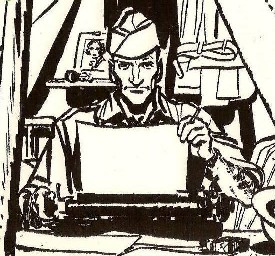Ernie Pike
| Ernie Pike | |
|---|---|
 Ernie Pike, drawn by Alberto Breccia. | |
| Publication information | |
| Publisher | Editorial Frontera |
| First appearance | Hora Cero #1 (May 1957) |
| Created by | Héctor Germán Oesterheld, Hugo Pratt |
Ernie Pike is a
Overview
The comic is set during
There are no recurring characters besides Ernie Pike, and in many cases even his presence is small: he appears in just two panels in "Kumba", only one in "El amuleto", and in some stories he is completely absent.
Creation
The name of the protagonist was reminiscent of that of Ernie Pyle, a well known real life war correspondent of the era. Unlike Ernie Pyle, Ernie Pike survives the war and is referenced as a veteran in other stories by Pratt. The face of Ernie Pike resembles that of Oesterheld himself. This was caused by a misunderstanding during the period of designing of the character: when Oesterheld was describing to Pratt the positive traits of the new character, he ended saying "Make him like me!". However, Pratt did not realize that Oesterheld was joking, and used his face. By the time Oesterheld realized the mistake, Pratt's work was already advanced, so he let it stay that way.[4]
Oesterheld was influenced by
Publishing history
The comic was first published in
Oesterheld worked again with Ernie Pike in the 1970 decade, in the "Top Maxi Historietas" comic book published by Cielosur Editora. The approach was slightly changed in this new run: instead of World War II, the stories were about the ongoing
There was a brief recreation of the character by other authors during the Falklands War. Ricardo Barreiro wrote "La batalla de las Malvinas" (Spanish: The battle of the Malvinas), penciled by Alberto Macagno, Carlos Pedrazzini, Marcelo Pérez and César Medrano. This story lasted for 7 issues of the magazine Fierro, ending inconclusively. Ernie Pike was included as a guest-star, placed in Patagonia as an aged war veteran, watching the events unfolding.[10]
Several volumes of Ernie Pike by Oesterheld-Pratt - along others of Sergeant Kirk - were reprinted in 2006 for the "Nueva Biblioteca Clarín de la Historieta" collection published by Clarín newspaper. Previously, Ancares Editora had reprinted the volumes by Oesterheld-Breccia in 2002.
Bibliography
- ISBN 978-950-581-261-5.
- ISBN 978-950-782-887-4.
- Martignone, Hernán; Dr. Sax (August 2005). "Alberto Breccia + Héctor G. Oesterheld". ISSN 1669-3329.
- ISBN 978-987-9085-29-5.
